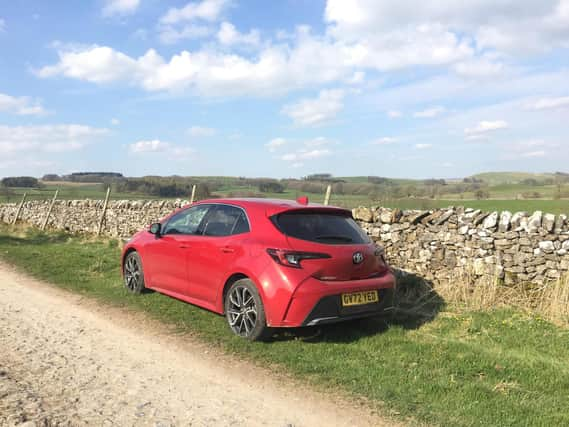Toyota: Corolla enjoys a surge as car sales take off


Some stars are dimmer. Tesla lost 14 per cent. Some stars get brighter. Volkswagen put on 55 per cent to take over from Ford as the number one seller. Much of it is to do with how carmakers are managing supply of components and meeting the demand from customers.
Nissan’s new Qashqai from Sunderland is the best seller but giant Toyota remains the number one Japanese marque. Its factory near Derby makes this week’s contender for happy motoring, the latest Corolla Hybrid, which motors towards summer after some revisions. It has the familiar self-charging petrol/electric system, incidentally the largest growth sector according to SMMT figures. They automatically run on electric power when possible, saving petrol and emissions.
Advertisement
Hide AdAdvertisement
Hide AdPure electric battery cars continue to gain sales, supported by the company car taxation banding and tempting monthly payments for three years, before the batteries lose their range. Electric motoring is pleasant but can be bland — and awfully expensive and bothersome.
FIAT’s Abarth performance brand has just launched the 500e. It has a sound generator to replicate the aural joy of Abarth exhausts. That took two years, with six months of continuous work and more than 6,000 hours spent analysing and creating the perfect sounds. There is an on/off switch, by the way. Those Italians like their Abarths to be loud.
Shoosh. Being a mix of electric and petrol, with ye olde worlde exhaust piping and induction roar, the Corolla Hybrid has its own, though quieter, melodies. Corolla is the world’s biggest-selling model name (more than 44 million, and six other Toyotas have each sold more than ten million) and the company’s excellent hybrid system has just reached its fifth generation. There is more power and pace from the Deeside-built 1.8 and 2.0 engines, more safety, lighter components (20kg alone on the transaxle, 14 per cent saved by the smaller yet beefier lithium ion batteries).
There is a lot of smart computerised techie stuff to refine the drive, improve economy and stop you crashing. The front radar has increased its range and in spotting the closeness of things like bollards.
Advertisement
Hide AdAdvertisement
Hide AdExample, entering a parking slot the brakes slammed on so fiercely I was convinced I’d hit something. The radar had reacted to a low kerb and some shrubs. There is increased lane breadth in monitoring and avoiding oncoming traffic and to the side, including cyclists. It will also prevent lane-wandering, for example unintended undertaking.
The Excel version adds blind spot monitors which warn of overtaking traffic and hoots if you open a door in the face of cyclists.
I could go on and on. Better to talk to your dealer and explore these aids on an accompanied test drive. It is safer that way.
There are upgrades to the digital instruments and even in their themes, from casual, smart or tough sporty (sic). Exterior changes alter, in small details, the grille mesh, fog light bezels and wheel designs.
Advertisement
Hide AdAdvertisement
Hide AdThe models start with the Icon, from £30,210 in the hatchback body with the 1.8 engine, or £31,955 with the 2.0 engine, each available with the Touring Sports estate body for an extra £1,335. Standard kit includes CVT automatic gears, sensible 16-inch alloys with comfy tyres, LED headlights, a large switchable display, navigation, a wireless phone charging pad, push button ignition, dual zone air conditioning, a reversing camera, front and rear parking sensors with the auto-braking mentioned, heated front seats, various safety systems and wireless software updates.
The Corolla range then goes to Design (bigger wheels for instance) from £31,780, GR Sport (even bigger wheels, same power) from £32,990 and Excel (loads more stuff, like leather and head up display) from £33,400.
Toyota sent us the Excel hatchback with the 2.0 engine, costing £35,145 plus £940 for the red pearlescent paint. It was very nice, too, but I’d be happy with the Icon as a cash buyer. However, PCP monthly deals take the sting out of the price gaps.
When we tested the previous Corolla Hybrid last June you could buy the 120bhp 1.8 from £23,755 and the 180bhp 2.0 from £23,755 and a 1.2 without hybrid power from £21,305.
Advertisement
Hide AdAdvertisement
Hide AdPrices are now much higher. In return you get more power, more safety and user technology, whether you want it or not. The 1.8 has 138bhp and the 2.0 a hefty 193bhp.
Ratings are around 64mpg and 100g CO2 (varying slightly with wheel sizes). The 1.8 has a 0-62mph time of 9.1 seconds while the 2.0 is decidedly brisk at 7.4 seconds.
This was a delightful car. I like the subtle shape (avoiding sportif style excesses) and the refinement and the everyday driving pleasure and fuel economy.
Now, as a year ago, the jarring feature was tyre noise, using the same Falken brand from Turkey, where Toyota makes the C-HR hybrid, but maybe the fault lies elsewhere in the chassis.
Toyota Corolla Hybrid
Advertisement
Hide AdAdvertisement
Hide AdIt is: Five-door hatchback or estate (plus a 1.8 LCV van) with front wheel drive, choice of four trims, two engines with CVT automatic gears. Made proudly in Burnaston, near Derby.
Prices: From £30,210 to £36,860. LCV £29,365 VAT paid. Model tested: Excel 2.0 hatchback £36,105.
Performance: 112mph maximum and 0-62mph 7.4 seconds. Power: 193bhp.
Economy: Usually above 50mpg and typically nudging 60mpg. Officially, 61.4mpg and 103g.
Length: 172 inches. Tank: 9.5 gallons (43 litres).
Or: Toyota builds the Corolla estate for Suzuki, named the Swace, with the 1.8 engine and without integrated navigation (relying on your phone), from £28,999.
Comment Guidelines
National World encourages reader discussion on our stories. User feedback, insights and back-and-forth exchanges add a rich layer of context to reporting. Please review our Community Guidelines before commenting.